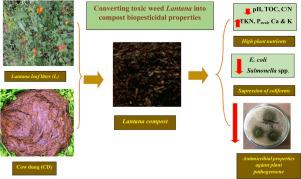Journal of Hazardous Materials ( IF 12.2 ) Pub Date : 2020-06-29 , DOI: 10.1016/j.jhazmat.2020.123332 Rani Rai 1 , Raj Kumar Singh 2 , Surindra Suthar 1

|
Toxic weed Lantana camara foliage was composted with cow dung in 2:1 and 1:1 ratio (v/v) and changes in physicochemical characteristics, and faecal coliform bacterial population (Escherichia coli and Salmonella) was estimated for 35 d. Results showed a significant increase in total N (1.48-1.69-folds), Paval (6.87-9.19-folds), and total K (1.08-1.23-folds) content, while a decrease in C/N ratio (1.87-2.13-folds) and total organic carbon (1.12-1.46-folds) after composting process. Germination index (GI) results (> 70 %) suggested the non-toxic property of Lantana compost against tested rapeseed mustard seeds. E. coli and Salmonella population reduced to the safe limit after 35 d composting. Compost extract (sterilized and non-sterilized) (from 2:1 setup) showed about 0.88 – 1.08-, 0.88 – 0.96-, 0.83 – 0.94-, and 0.79 – 1.08-folds higher inhibition in Xanthomonas citrus, Xanthomonas campestris, Erwinia carotovora, and Pseudomonas aerogenosa, respectively, indicating strong pathogen-inhibiting substances in Lantana compost. GC-MS analysis of compost extract indicated the presence of isomers of several compounds of biocidal property – hexadecane (9-hexyl and 9-octyl); 2-tridecyl ester; eicosane; tetradecane, heptacosane (1-chloro- and 9-hexyl); heptadecane, octadecane, 3-ethyl-5-(2-ethylbutyl)-, heptacosane, tetradecane, 2,6,10-trimethyl-, etc.). Result revealed that Lantana compost could be used as biomanure with biopesticide properties for sustainable organic farming system.
中文翻译:

从有毒杂草马tana丹生产具有生物农药特性的堆肥:堆肥和抑制细菌病原体中生物碱的定量。
将有毒杂草马tana丹(Mantana camara)叶子与牛粪混合,以2:1和1:1的比例(v / v)堆肥,理化特性发生变化,估计粪便大肠菌群(大肠杆菌和沙门氏菌)持续35 d。结果表明,总氮(1.48-1.69倍),Paval(6.87-9.19倍)和总钾(1.08-1.23倍)含量显着增加,而C / N比(1.87-2.13-倍)降低。堆肥后的总有机碳(1.12-1.46倍)。发芽指数(GI)结果(> 70%)表明,马tana丹堆肥对测试的菜籽芥菜种子无毒。堆肥35天后,大肠杆菌和沙门氏菌种群降至安全限度。堆肥提取物(灭菌和未灭菌)(从2:1设置)显示为约0.88 – 1.08-,0.88 – 0.96-,0.83 – 0.94和0.79 – 1。柑橘黄单胞菌,油菜黄单胞菌,胡萝卜欧文氏菌和铜绿假单胞菌的抑制作用分别高08倍,表明马Lan丹堆肥中的病原体抑制物质很强。堆肥提取物的GC-MS分析表明,存在几种具有杀生物特性的化合物的异构体,即十六烷(9-己基和9-辛基);2-十三烷基酯;二十烷 十四烷,庚烷(1-氯和9-己基);庚烷,十八烷,3-乙基-5-(2-乙基丁基)-,庚烷,十四烷,2,6,10-三甲基-等)。结果表明,马Lan丹堆肥可作为具有生物农药特性的生物肥料用于可持续的有机耕作系统。堆肥提取物的GC-MS分析表明,存在几种具有杀生物特性的化合物的异构体,即十六烷(9-己基和9-辛基);2-十三烷基酯;二十烷 十四烷,庚烷(1-氯和9-己基);庚烷,十八烷,3-乙基-5-(2-乙基丁基)-,庚烷,十四烷,2,6,10-三甲基-等)。结果表明,马Lan丹堆肥可作为具有生物农药特性的生物肥料用于可持续的有机耕作系统。堆肥提取物的GC-MS分析表明,存在几种具有杀生物特性的化合物的异构体,即十六烷(9-己基和9-辛基);2-十三烷基酯;二十烷 十四烷,庚烷(1-氯和9-己基);庚烷,十八烷,3-乙基-5-(2-乙基丁基)-,庚烷,十四烷,2,6,10-三甲基-等)。结果表明,马Lan丹堆肥可作为具有生物农药特性的生物肥料用于可持续的有机耕作系统。










































 京公网安备 11010802027423号
京公网安备 11010802027423号